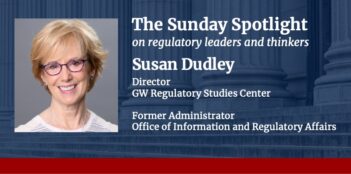
Benefit-cost analysis experts advocate changes to a draft update of OMB Circular A-4.
The Office of Management and Budget (OMB) recently proposed revisions to its guidance on best practices for conducting regulatory impact analysis, updating the guidance in Circular A-4 issued 20 years ago.
In a letter to OMB’s Office of Information and Regulatory Affairs Administrator Richard Revesz, former presidents of the Society for Benefit-Cost Analysis and editors of the Journal of Benefit-Cost Analysis noted that they support efforts to revise the Circular to reflect developments in the field. We and the others who signed that letter, however, are concerned that some proposed changes deviate from the best available current economic science.
Circular A-4, and Executive Order 12866 on which it is founded, have proven durable across many presidential administrations, Democratic and Republican, because both are based on objective and nonpartisan principles. These documents are designed to provide information to policymakers and stakeholders on an important dimension of regulatory decisions—the efficiency of different approaches to achieving policy goals.
Regulatory impact analysis informs policy decisions; it does not determine them. Benefit-cost analysis (BCA), an important component of regulatory analysis, applies an economic lens to examine whether the overall costs of a regulation can be justified by the benefits it generates. The goal is to help promote efficiency by identifying policies that would yield the greatest positive net benefits to society. Policymakers must consider other factors when making regulatory decisions, including legal constraints, political viability, distributional impacts, practicality, among others. But as the original Circular notes, BCA provides “useful information for decision-makers and the public, even when economic efficiency is not the only or the overriding public policy objective.”
To retain the integrity of regulatory impact analysis and OMB’s role in providing a “dispassionate and analytical second opinion” on agency actions, the letter we signed offered the following recommendations.
First, the revised Circular should focus on basic principles that are universally applicable—emphasizing the need for evidence-based analysis and for transparent discussion of data sources, assumptions, and associated uncertainties. At almost twice the length of the original, the draft is dense and repetitive. As a result, important points are often obscured and requirements are at times unclear. In attempting to cover a wide range of possible scenarios, the draft changes to the Circular risk creating confusion as well as conflict with the legal context within which some agencies operate. Shortening and reorganizing the guidance to emphasize key points and methods will ensure that it is both useful and used, and yield more meaningful analysis that could be more readily communicated to the officials responsible for setting policy and the public.
Second, the revised draft Circular contains an extensive new section on assessing the distribution of impacts across advantaged and disadvantaged groups. This addition is appropriate as few, if any, regulatory analyses currently provide data on the distribution of both costs and benefits based on income or other socioeconomic factors. The draft’s proposal to apply different numerical “weights” to benefits and costs based on income or other group characteristics, however, is not supported by widely accepted principles, nor is there professional consensus for making such interpersonal utility comparisons. Rather than encouraging agencies to embed weights that reflect particular normative frameworks and are difficult to understand and interpret, Circular A-4 should advise agencies to present information on distributional impacts as clearly as the evidence permits. That would give policymakers the information necessary to make normative policy decisions that take the incidence of regulatory benefits and costs into account.
Third, the draft Circular would direct agencies to use a default rate of 1.7 percent to discount all effects for up to 30 years into the future, and lower rates thereafter. The appropriate rate for discounting future benefits and costs, however, is far less settled in the economic literature than such a precise figure warrants. Given the complexity of the subject and the important effect discount rates have on estimates of benefits, costs, and net benefits, the Circular should not direct agencies to use a single number. Instead, it should provide a range of perhaps two or three rates and direct agencies to use the range to demonstrate the sensitivity of the results to the choice of discount rate.
Fourth, even though we agree that advances in behavioral sciences merit attention in the revised Circular, the draft gives agencies considerable latitude for choosing to regulate based on paternalistic assumptions that people are not acting in their own interest. Instead, the Circular should require agencies to “provide evidence that individuals behave irrationally (and do not learn) in the specific situation covered by the proposed regulation” before presumed behavioral biases can be used to justify overriding individual choices.
Finally, we agree that considering effects that fall on people outside the United States is appropriate when they are significant. In these cases, however, policymakers will be better informed if agencies provide a separate analysis of “the benefits and costs that accrue to U.S. citizens and residents,” as required in the current Circular A-4, rather than only presenting a global figure as suggested in the draft revisions. Transparency concerning where the likely benefits and costs will fall geographically is essential for understanding distributional impacts, as well as for complying with statutory mandates.
The letter we signed emphasizes the importance of the durability of Circular A-4, which has earned bipartisan acceptance across several very different administrations. Some of the draft changes propose specific approaches or estimates rather than encouraging agencies to examine a range of plausible estimates and the underlying evidence. A focus on a single number or approach can create an unwarranted sense of precision, which departs from widely accepted practices and principles for incorporating uncertainty. To the extent the Circular is perceived as favoring particular policy preferences, a future administration with a different set of policy preferences would likely replace it with another Circular designed to support its preferred policies, leading to wide swings in regulatory actions.
We believe that, after 20 years, revisions to Circular A-4 are appropriate and timely. We also believe, however, that the Circular should focus on basic, widely accepted principles that have bipartisan support and not risk revision with each incoming administration.










